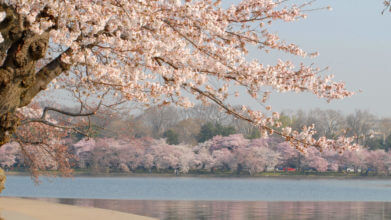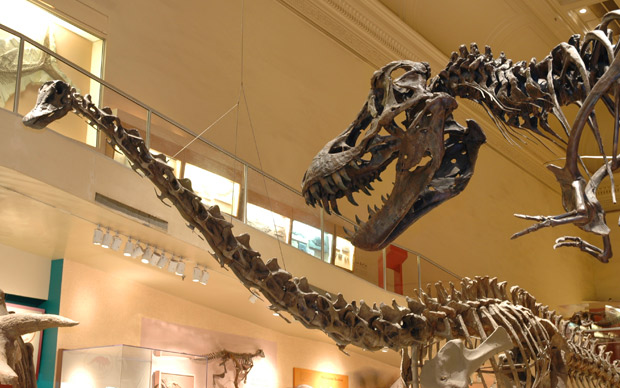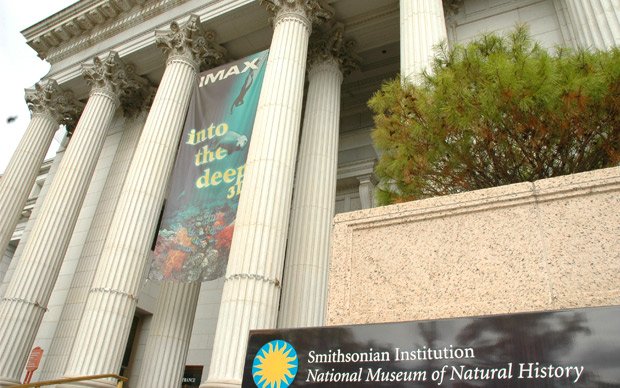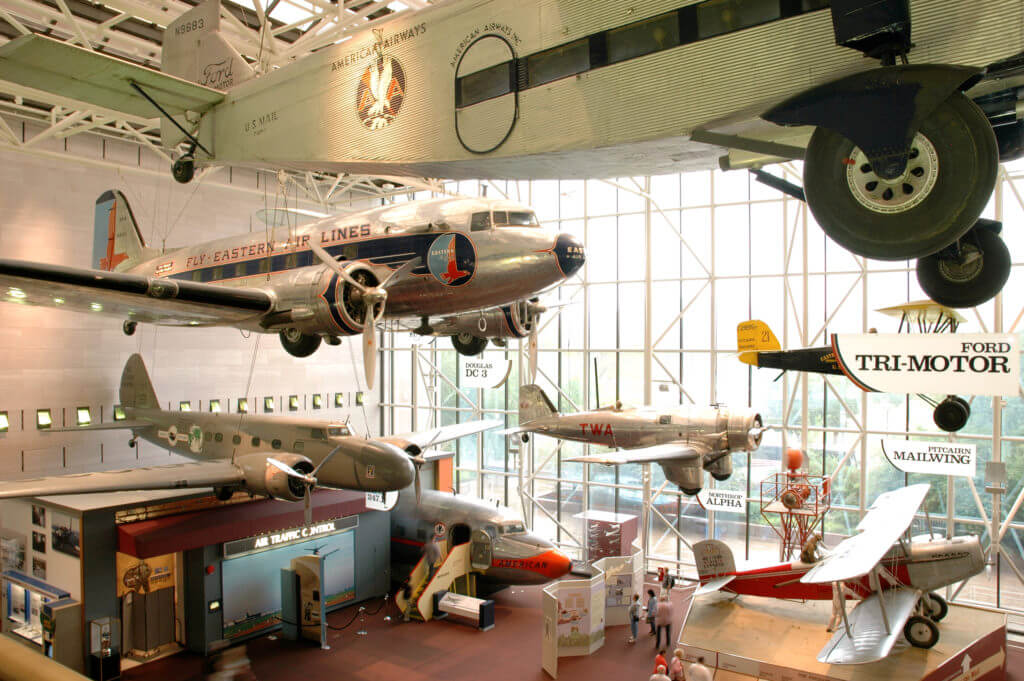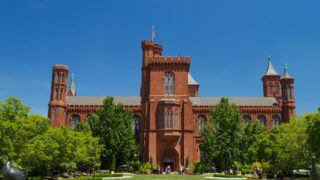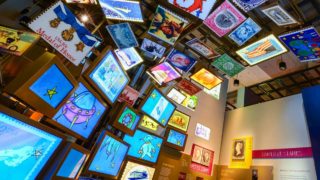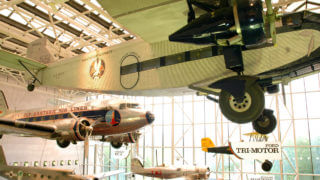Smithsonian Museum of Natural History
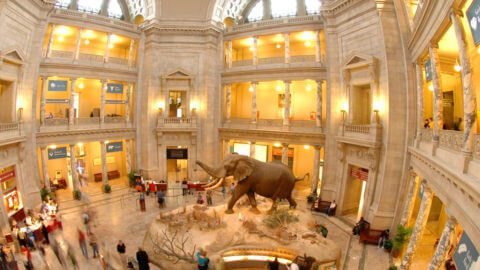
Smithsonian's Museum of Natural History
Ever wonder if there’s any truth to the curse of the famous Hope Diamond? Or wish you could see for yourself the fossils of an ancient mammal or a dinosaur? Then step inside the Smithsonian’s National Museum of Natural History. Millions of people come each year to get a close look at some of the world’s most intriguing, beguiling specimens that the Museum has on display.
As part of the Smithsonian Institution, the museum offers an astounding view of the natural world, from rare gems, minerals and animals to insects, plants and other interesting items. See for yourself the amazing beauty of the Hope Diamond or the incredible remains of an ancient bull.
In its 1.5 million square feet, more than 125 million pieces are on display.
Explore and discover the intricacies of the natural world, feed a real tarantula and witness the living history of various species. From interactive exhibits to tours, educational programs and fascinating demonstrations, the museum is one of the most thrilling experiences in the National Mall.
The History of the Museum
Tracing its roots back to the founding of the institution, the museum’s collection was initially housed in the Smithsonian Castle. Then known as the National Museum Building, the Arts and Industries Building was constructed in 1881 to house the institution’s growing number of exhibits. As the collection outgrew its second home, building, Congress authorized the construction of a larger structure. Opening in 1910, it was the first Neoclassical-style building to be erected on the north side of the National Mall. The building’s green dome is an iconic landmark along the Mall.
Inside the Museum
Henry, the museum’s iconic 14-foot-tall, 12-ton African elephant that made its debut in 1959, greets visitors in the rotunda. A recent renovation of the rotunda revealed a once hidden compass inlaid in the floor.
In addition to the Hope Diamond, the Janet Annenberg Hooker Hall of Geology, Gems and Minerals also displays the Star of Asia Sapphire and the Gachala Emerald as well as an extensive collection of meteorites.
The David H. Koch Hall of Human Origins opened on the 100th anniversary of the current building. The exhibits chronicle the primordial record of human life on the planet. The primary exhibit focuses on the aspects that make humans unique. Topics include the size of the brain as well as the ability to walk upright and to use complex verbal and nonverbal communication. The highlight of the hall is an authentic Neanderthal fossil.
The Hall of Dinosaurs and Paleobiology, featuring a collection of 46 complete dinosaur specimens, reconstruct the history and behavior of these extinct creatures. The gallery also documents the region’s ancient climate and terrain that served as the natural habitat for these massive animals. Highlights include complete skeletons of a T-Rex, a megacerops and a triceratops.
Visitors to the National Museum of Natural History can learn about various creatures that have resided on the planet in galleries dedicated to mammals, insects and the world’s oceans. The museum has the largest collection of vertebrate specimens that trace the adaptations of mammals to their diverse and changing surroundings. Highlights include the lion and polar bear exhibits. The Orkin Insect Zoo reveals how various types of insects thrive in different environments, such as rain forests, swamps and deserts. Children will enjoy watching the live tarantula feedings. The Sant Ocean Hall highlights the biodiverse world that exists beneath the waves. The 1,500-gallon aquarium features a live tropical Pacific coral reef and a giant squid. The Butterfly and Plants pavilion enables visitors to observe the symbiotic relationship between plants and these colorful creatures.
The cultural history of humans is also on display. Exhibits trace the development of western civilization from ancient Mesopotamia, Egypt and Greece as well as the unique cultures and traditions of Africa and Asia. In addition to seeing how people live and work in their natural surroundings, you will see how they affect these environments. One example of this dynamic relationship is the mud masons of Mali who built Djenne, a UNESCO World Heritage Site known for its intricate earthen architecture.
Q?rius is the museum’s education center where teens and preteens can get hands-on experience working in a lab and making their own scientific discoveries. The Johnson IMAX Theater shows feature-length nature films in 3D. Performances sellout early, so purchase your tickets when you first arrive at the museum. The facility also hosts sleepovers for children ages 8 to 12 years old.
Know Before You Go
With free admission, the museum is open every day except Christmas. Normal operating hours are from 10 a.m. to 5:30 p.m. with extended hours during the summer. Public parking near the building is scarce. The best way to reach the museum is using the hop on hop off features of Old Town Trolley.
If you choose public transportation, The Smithsonian and Federal Triangle Metro stations serving the Orange and Blue lines are situated nearby. You can also use the Archive-Penn Quarter station on the Green and Yellow lines. The best times to visit the museum are Monday through Wednesday. The museum is busiest on Saturdays, and the peak tourist season is from mid-March through late-July.
There are two entrances to the museum. One is located on Constitution Avenue, which is on the north side of the building. The other faces the National Mall on the south side. On busy days, one security line may be shorter than the other one. You will pass through a security checkpoint similar to those at airports before entering the museum. While strollers, cameras and bottle water are permitted, the museum asks that you do not bring camera stands, objects that can be used as weapons and aerosol sprays. Service animals are allowed. Visitors are permitted to take still photographs and videos for noncommercial purposes.
Nearby Attractions
Several other popular Smithsonian Institution museums are located on the Mall within a short walking distance of the Museum of Natural History.
The adjacent National Museum of American History accumulates, preserves and displays a collection of artifacts related to the cultural, political, military and social heritage of the United States. National treasures on display include the original Star Spangled Banner that inspired Francis Scott Key and Dorothy’s Ruby Slippers from the Wizard of Oz.
The National Gallery of Art is one of the world’s pre-eminent fine art museums. It houses a collection of more than 140,000 works tracing Western art from the Middle Ages until the present day. The paintings, sculptures and other pieces include works by masters, such as Edgar Degas, John Singleton Copley and Leonardo de Vinci.
The fifth most-visited museum in the world, the National Air and Space Museum chronicles the history of flight and space exploration. It holds the world’s largest collection of historic aircraft and spaceships as well as related artifacts, including the Wright Brothers Flyer and a moon rock. The Stringfellow steam engine, originally designed to power aircraft, was the first item ever acquired by the Smithsonian Institution.




